Correct cultivation of cucumbers in a polycarbonate greenhouse
Growing vegetables in a greenhouse can be much faster than growing outdoors, especially in areas with unstable temperatures. If earlier greenhouse structures were made independently using glass or plastic film, nowadays summer residents are offered compact, easily assembled structures made of polycarbonate... They are suitable for planting cucumbers, which can be harvested even in early spring.
Fresh cucumber salads - what could be healthier and tastier in early spring, when the body missed vitamins so much? It is also possible to collect the first cucumbers in the summer cottage, if you plant the vegetable seeds in a polycarbonate greenhouse correctly and on time. The selection of a variety and care for planting a vegetable has its own characteristics.
Content:
- The best varieties of cucumbers for a polycarbonate greenhouse
- Planting a vegetable: terms and rules
- Competent care of cucumbers in the greenhouse
- Diseases and pests of vegetables - control and prevention
- Advantages of growing cucumbers in a polycarbonate greenhouse
The best varieties of cucumbers for a polycarbonate greenhouse
The main condition for the fruiting of a green vegetable in an enclosed space is the pollination of the flowers of the plant, otherwise the ovaries will not form on them. Therefore, it is necessary to choose for sowing female-type varieties that do not need pollination, or with flowers of both sexes, self-pollinated.
Among the varieties of vegetables for greenhouses are considered the best:
- Blagovest has flowers of the female and male type. The variety is undemanding to lighting, the first harvest of greens can be obtained in early May. Cucumber bushes are highly branched, which allows you to feast on the lumpy tasty fruits in large quantities. The variety is resistant to the main types of diseases.
- Bushes bear fruit at the same time Zozuli, with a high yield of ten kilograms per square meter. Cucumbers are easy to grow, and the crispness, juiciness of the vegetable, its slightly sweet taste are noted by many. Suitable for growing in spring and summer.
- The Tournir variety is characterized by early ripening periods - up to fifty-seven days from germination. The bright green fruits of medium size do not have bitterness, they have an excellent taste. Resistant to powdery mildew.
- The Sultan hybrid is valued for its quick ripening, excellent presentation. Medium-sized zelents have good taste. The plant belongs to the parthenocarpic species with female-type flowers. Used fresh on salads.
- Improved taste, disease resistance, lack of bitterness, yield of more than twenty kilograms per square meter within fifty days after the first sprouts appear - all this is about cucumbers. Courage... You can use the fruits for salads, canning due to its small size. They tolerate transportation well, remaining undamaged after a long transportation. Breeders note the unpretentiousness of the variety when grown all year round in polycarbonate greenhouses.
- Greenhouse hybrid Bogatyrskaya power is easy to grow due to its resistance to many diseases.And versatility in use allows you to give preference to this species when choosing seeds for planting indoors.
It is better to plant cucumber seeds of different ripening periods in a greenhouse, which will allow harvesting throughout the year.
Planting a vegetable: terms and rules
Already in February, they begin to prepare the soil for spring planting cucumbers... This vegetable loves warmth and grows actively at temperatures above twenty degrees. Manure will help to create an optimal temperature regime. A bed of it is made like this: they go deep into the ground by forty centimeters, and the pothole can be one meter wide. Manure is put into it, and from above they are covered with earth with a layer of thirty centimeters. It is imperative to process the soil, for this they use bleach or preparations such as Fitosporin, Trichodermin.
Vegetable seeds are planted in the heated soil at the end of March.
And here it is important to pay attention to the temperature of the soil, it should not exceed thirty degrees Celsius, otherwise the seeds will simply burn out. The frequency of planting seeds reaches twenty centimeters between the holes, and the row spacing is at least 50. For quick emergence of seedlings, a film is pulled over the bed, creating a greenhouse effect for vegetable seeds.
The method of planting cucumbers in a greenhouse in a sprouted form is also widespread. In this case, the seedlings should be 20-30 days old. They are placed in the wells heated and disinfected with a solution of potassium permanganate. It is better to sow vegetable seeds for seedlings in peat pots, so that later they can be lowered into the soil. This will prevent the infection from damaging the root collar of the sprouts. To speed up the ripening time of the plant, after the appearance of the second leaf, pinch the top above it, leaving a stump of five millimeters.
If a polycarbonate greenhouse is heated in the form of water heating pipes, then it is possible to sow cucumbers for the winter table - until January 15, and with additional lighting - in the second half of December. For autumn-winter cultivation, plants are sown in the tenths of July. The greenhouse method of planting cucumbers is reliable, it will allow you to get harvests of zelents already at the end of spring, and in some cases, all winter.
Competent care of cucumbers in the greenhouse
The procedures for caring for cucumbers planted in a greenhouse are not complicated, requiring time and effort:
- Cucumber culture needs abundant watering, the frequency of which depends on the growing period of the plant and the temperature in the greenhouse. In cold weather, the beds are watered every three to five days, and in the spring and summer - up to twice a day. During flowering, the amount of watering is reduced, which will allow the rapid appearance of ovaries. The water temperature must be at least twenty degrees above zero. It is not recommended to water the sprouts at the root - this will lead to their decay. For this, grooves along the rows are suitable. One bucket of water is enough per square meter of planting. Every morning, cucumber plantings should be sprayed with warm water.
- For feeding alternate mineral fertilizers with solution mullein... At first, the concentration of the nutrient mixtures should be low so that the plant does not get burned. It can then be increased to a 1: 4 ratio for cow dung. When adding minerals at the first stage, fifteen grams of ammonium nitrate, forty grams of superphosphate and ten grams of potassium chloride per bucket of water are needed. As the plant grows, the rate is doubled. Nutrients are added every week.
- Pinching plays an important role in increasing the yield of zelents. Lateral shoots after the first procedure with the main stem are pinched, and this operation is done several times as the lashes grow. This will allow the bush to branch out and form new female flowers. When the roots of the plant are exposed, it is necessary to sprinkle the earth with a layer of three centimeters at the base of the stem.
After a month and a half, the development of the cucumber bush slows down. To renew the bushes, the stem is lowered to the ground, rolled up in a ring. After lying on the surface for some time, it will begin to take root.It will only need to be covered with a layer of earth. By properly caring for cucumbers in the greenhouse, you can achieve high yields.
Diseases and pests of vegetables - control and prevention
The delicate culture is often affected by fungi. Among them, white rot is especially dangerous, affecting all parts of the vegetable. In this case, the leaves, stem, fruits turn into a soft, mucky mass. Black spores of the fungus appear inside the stem. Having found a disease, it is necessary to quickly remove the affected areas. The stem is sprinkled with powdered charcoal. Dense plantings must be thinned out so that they are better ventilated. For the prevention and treatment of the disease, cucumber beds are sprayed with a solution of copper sulfate at a concentration of half a percent, and the soil is steamed with boiling water or completely replaced.
The appearance of brown spots on the leaves of the culture, and watery spots on the fruits is a sign of a fungal disease.
If you do not take action, then all zelents will have deep sores. Sick plants are sprayed with a solution of Bordeaux liquid at a concentration of one percent. The disease should be prevented by raising the temperature in the room to twenty-five degrees and reducing the humidity.
A sign of powdery mildew on a plant is a white bloom on the leaves. When a symptom of the disease appears, the plant should be sprayed with a solution of solbar - 50 grams per bucket of water or pollinated with sulfur powder.
Cucumber pests:
- Among pests, spider mites are especially common. He sucks the juices from the leaf, entangling it with cobwebs. The pest is especially dangerous for young plants. The infusion of onion peel helps well from it, which is sprayed on the bushes three times with an interval of ten days. Prepare a solution of twenty grams of husk per liter of boiling water.
- A lover of wet places, wood lice harm the plants in the greenhouse by gnawing the edges of the leaves. The same harm is caused by the earwig - an insect of brown-red color. Pests can be destroyed with a mixture of kerosene and lime, by treating the soil with it.
- For the fight against melon fleas and flies, there are special preparations - Belofos, Arrivo.
By airing the greenhouse constantly, creating a moderate concentration of moisture, you can save the cucumber crop from fungal diseases, harmful insects.
Advantages of growing cucumbers in a polycarbonate greenhouse
Advantages of using a greenhouse for growing cucumbers obvious:
- Polycarbonate perfectly transmits up to 90 percent of sunlight, preventing the leaves of the plant from being burned by ultraviolet rays.
- There are no temperature fluctuations in the room. Warming up well in the sun, the material retains heat for a long time.
- Cucumber ridges protected by durable material will not be damaged by hail, broken by the wind during bad weather.
- It is easy to create a greenhouse heating, which will help to feast on fresh cucumbers in winter.
- When lighting the greenhouse, you can plant cucumbers from February 15.
- When growing a vegetable crop indoors, there is no need to be afraid of a drop in air temperature outside. Polycarbonate will save plants from death.
In order to completely protect greenhouse plants from the effects of pests, diseases, the room must be ventilated during the day, and the temperature and humidity in it must be monitored.
More information can be found in the video:



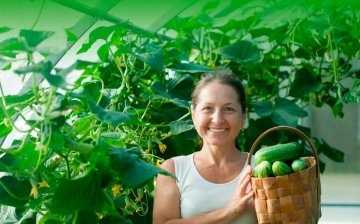
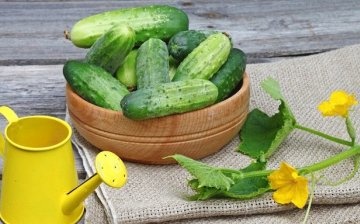
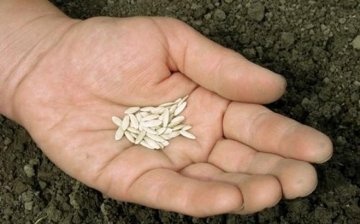

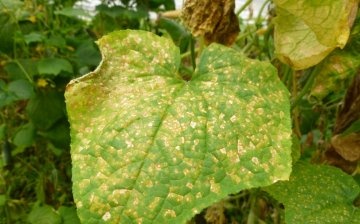
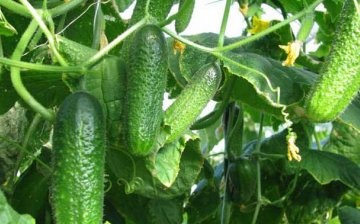






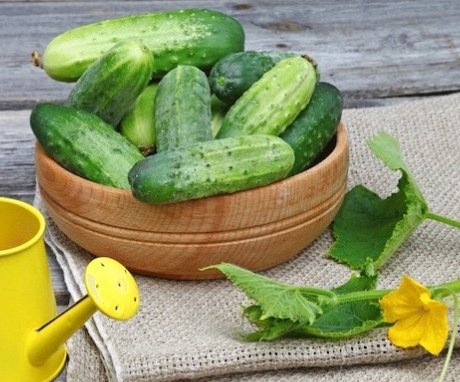
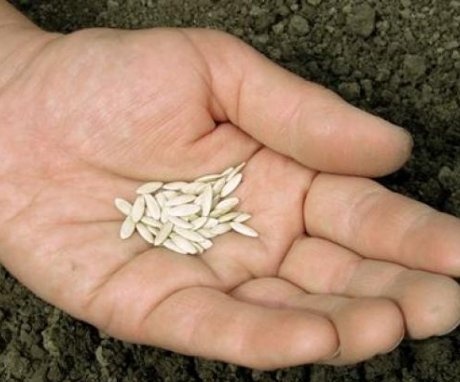

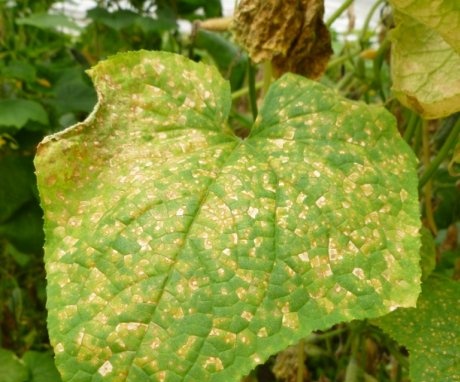
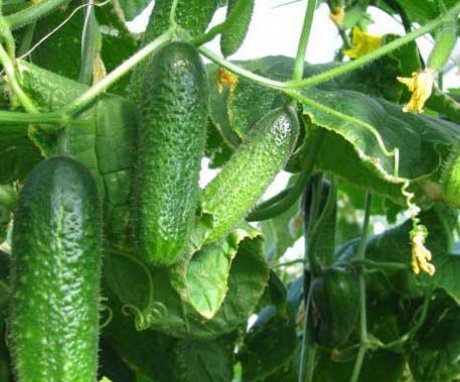
I just bought myself a private plot and put greenhouses there, so this information is very relevant to me. I've never been able to decide what sort of cucumber is best to grow, now I know what's what!
We recently moved to our house and there is a greenhouse on the site. Last year I planted cucumbers and bought seedlings late last year, and this year I want to buy seeds myself and plant them. Very useful information, I did not know that it is possible to plant varieties of different ripening periods.